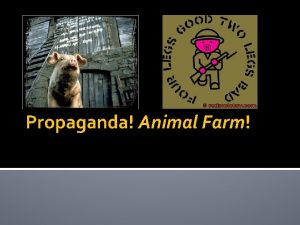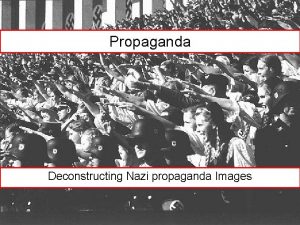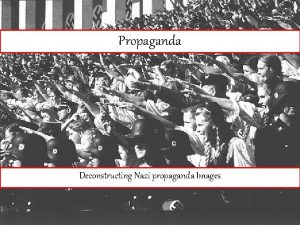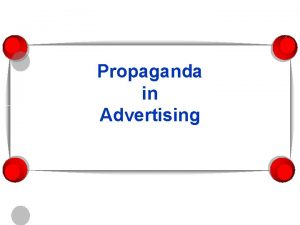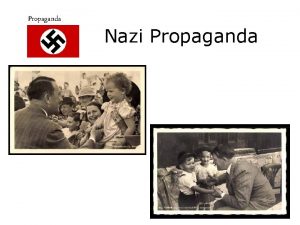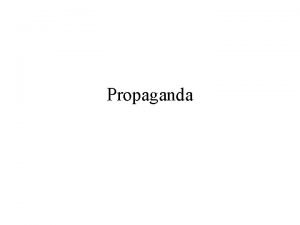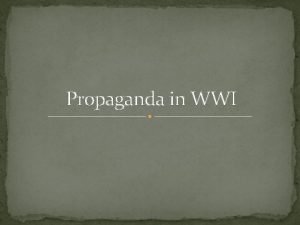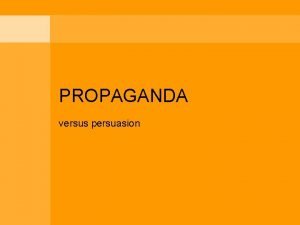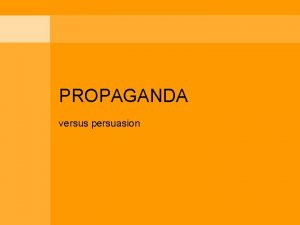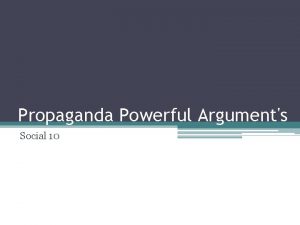Propaganda Whats the message What is propaganda Propaganda



















- Slides: 19

Propaganda: What’s the message?

What is propaganda? Propaganda- Did you know the average teen is exposed to over 3, 000 advertisements per day? Without the skills to look critically at all these messages, it’s easy to be persuaded by them without even realizing it. Propaganda is media that uses carefully-crafted messages to manipulate people’s actions and beliefs. It has one purpose, and one purpose only: to persuade you. There a variety of propaganda techniques. They use biased, or one-sided, messages and are designed to appeal to peoples’ emotions instead of their judgment and reasoning. How many of the following techniques do you recognize from your own exposure to propaganda?

Testimonials tell a story! • Testimonials-usually involve celebrities or other respected people endorsing, or officially supporting, a product or idea. The person giving the testimonial could be famous, knowledgeable about the product (such as a doctor talking about medicine), or just an ordinary person who claims the product has worked for them. When the testimonial comes from a celebrity, the hope is that you will want to use the product or support the idea simply because they do. Other testimonials try to persuade you to use or support something because it is good for you or it worked for others. Beware, though, because people are usually paid to give endorsements (except in politics). Ask yourself: Who is quoted in the testimonial? Is this person actually an expert about this product or idea? Does the product or idea have value without the testimony or endorsement?

All aboard!!- Bandwagon • Bandwagon “Jumping on the bandwagon” describes people choosing to go along with the rest of the crowd. Bandwagon propaganda creates the impression that there is widespread support for a thing or idea. People tend to want to be on the winning team and try to avoid being the odd one out. These messages create a sense of peer pressure to join in. Ask yourself: Does the message provide reasons for joining the group? Is there any evidence for or against joining in?

What’s in a name? • Name-Calling- is exactly what it sounds like: using negative words and bad names to create fear and dislike for people, ideas, or institutions. Name-calling can be verbal or visual. When done visually, it shows a person or thing in an unflattering way. You can find both kinds of this technique in political cartoons, political attack ads, and on news talk shows. Ask yourself: Who is being called what? Is there a real connection A 2008 political cartoon showing the between the names and the person/idea being attacked?

Glittering Generalities- This technique always shows the subject of the message in a positive light, but provides little or no information. Glittering generalities use simple, clever slogans that appeal to peoples’ emotions. These general statements are easy to remember but hard to verify because they offer no facts. Ask yourself: What do these slogans or catchphrases really mean?

Stacking the Deck!! • Card Stacking -uses facts and figures to show one side as positive and the other side as negative. The message shows only positive information about the person, product, or idea being promoted, and it shows only damaging information about the opposition or competition. This technique is designed to make you think you are hearing both sides. In reality, you are actually hearing only one perspective. Ask yourself: Are facts being changed or left out? What other pieces of information do I need to make an informed decision?

Just like you and me! • The plain folks- technique is designed to send the message that a product or person is “just like you. ” An advertiser will show an ordinary-looking person who vouches for how well a product works. Politicians have their picture taken visiting coffee shops, riding on tractors, and doing other things that everyday people do. The goal is to gain your trust by showing that people just like you use the product or support the person. Ask yourself: Can I trust the person who is speaking or acting? What are the person’s motive

The Transfer affect! The transfer technique uses your feelings about one thing to get you to feel the same way about something else. Transfer can use a positive image to persuade you to like something or a negative image to persuade you to dislike something. The images might be symbolic, such as a flag standing for patriotism. They might be cute and lovable, such as a baby penguin. The images could be repulsive, such as diseased skin in an anti-smoking campaign, or they could be hateful, such as comparing a politician to Adolf Hitler. However they are presented, the images act as wordless messages that most people can identify with. Ask yourself: What is the image trying to get me to feel? Is there an actual connection between the image and the person or product?

Propaganda Does not really care about truth or lies. It only wants you to be persuaded by the message! Propaganda is not really care about telling lies or spreading truths. It only cares about action…your action. It is used all over the world, by virtually every government and news media of all different stripes. It has been used for generations because it works! The key for you is to tell what is propaganda and what is not.

How and why does propaganda work? Propaganda works because it appeals to our emotions and fears. Since every person is an emotional being, propaganda is specifically designed to get us not to think about the truth of something by appealing to our emotions first. The hope is that by appealing to our emotions, enough people will be convinced to act, and not care about what they are being told is true or not, as seen in this example to the right. This was shown during World War Two in an effort to get Americans to enlist and fight Nazi Germany. “Huns Kill Women and Children!”

How does propaganda work: Continued Sometimes the whole idea of “truth” is called into question. That is because governments that have employed the use of propaganda, have often included partial truths to get you to buy into their argument.

How does propaganda work: Continued Propaganda plays uses our own societal values and twists them to make us agree or do something because it is very difficult to disagree with the message. Example: Going to war to defend the nation is seen as something that is right and something everyone must do if called upon by the government. Those men who did not want to fight risked being shamed by their own society if they didn’t enlist. As this poster did on the right during World War Two!

Propaganda makes us all want to conform or risk being excluded!! Finally, propaganda works because the message is designed to get us to cooperate and go along with what everyone else may be doing. That’s why shaming works, that’s why testimonials work and that’s why the bandwagon technique is so effective…because we all want to be seen as part of the group, and not an outsider. If you aren’t with “us” you are “against” us. No one wants to feel like they aren’t part of the group or the community.

Propaganda Cartoons! • When looking at cartoons, consider everything from the words being spoken, the shading, the characters in the cartoon and even the author, if is provided, who made the cartoon. You should try and answer the following questions whenever you are analysing political cartoons: - What is the explicit message of the cartoon? (What do you see happening in the picture? ) - What is the “implied message”. This is the hidden message of the cartoon that the author is trying to convey. - What do you think is the point of view of the author? (Is the message of the cartoon obvious or over the top) - Are there any stereotypes present. Example: All Americans love football, or all Canadians love maple syrup.

What do you see happening in these cartoons? Cartoon 1: 2016 US Federal Election Cartoon 2: Trump and the 2016 Presidential Election

What do you see happening in these cartoons? Cartoon 2: Hillary Clinton and 2016 Presidential Race Cartoon 3: US Immigration Before World War Two

What is the message of thes propaganda posters? Poster 1 Poster 2

What is happening in these propaganda posters? Poster 4 Poster 3
 Hát kết hợp bộ gõ cơ thể
Hát kết hợp bộ gõ cơ thể Slidetodoc
Slidetodoc Bổ thể
Bổ thể Tỉ lệ cơ thể trẻ em
Tỉ lệ cơ thể trẻ em Gấu đi như thế nào
Gấu đi như thế nào Chụp tư thế worms-breton
Chụp tư thế worms-breton Chúa sống lại
Chúa sống lại Môn thể thao bắt đầu bằng từ chạy
Môn thể thao bắt đầu bằng từ chạy Thế nào là hệ số cao nhất
Thế nào là hệ số cao nhất Các châu lục và đại dương trên thế giới
Các châu lục và đại dương trên thế giới Công thức tiính động năng
Công thức tiính động năng Trời xanh đây là của chúng ta thể thơ
Trời xanh đây là của chúng ta thể thơ Mật thư anh em như thể tay chân
Mật thư anh em như thể tay chân Phép trừ bù
Phép trừ bù Phản ứng thế ankan
Phản ứng thế ankan Các châu lục và đại dương trên thế giới
Các châu lục và đại dương trên thế giới Thể thơ truyền thống
Thể thơ truyền thống Quá trình desamine hóa có thể tạo ra
Quá trình desamine hóa có thể tạo ra Một số thể thơ truyền thống
Một số thể thơ truyền thống Cái miệng nó xinh thế chỉ nói điều hay thôi
Cái miệng nó xinh thế chỉ nói điều hay thôi























